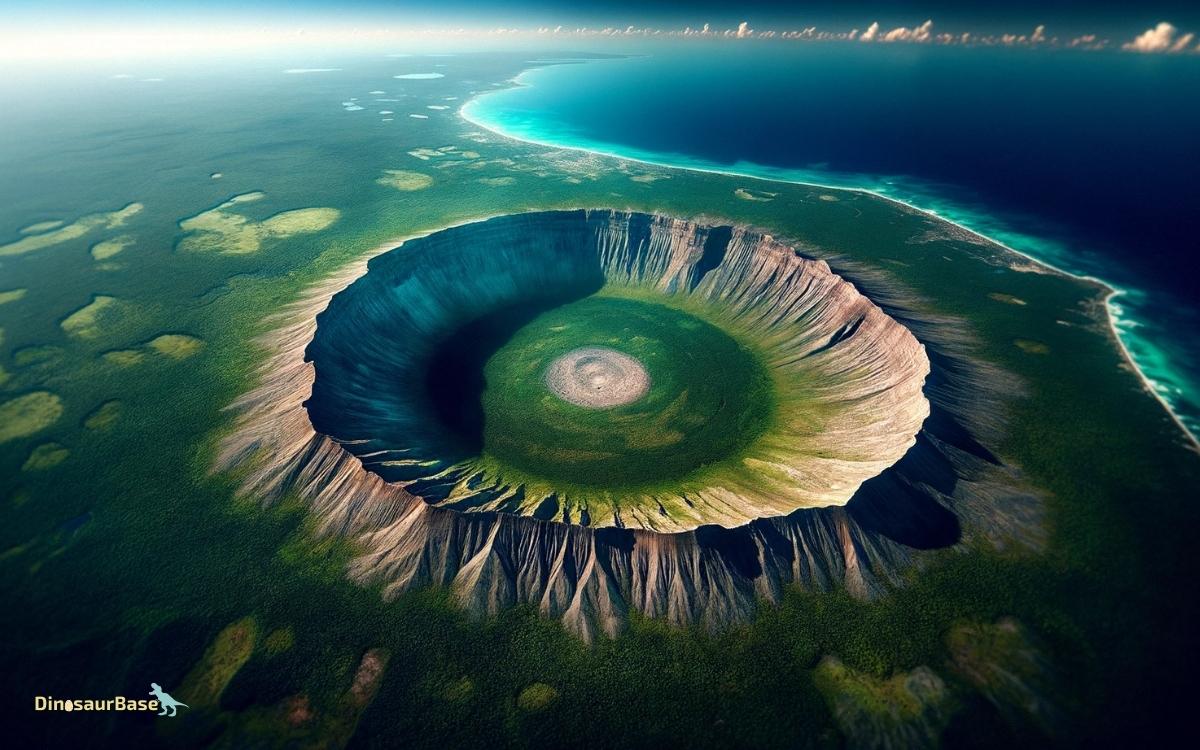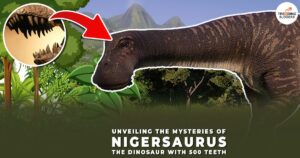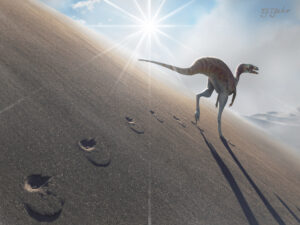Where Did Dinosaur Asteroid Hit? Yucatán Peninsula!
The cataclysmic event that led to the extinction of the dinosaurs has fascinated scientists and the public alike for decades. Central to this intrigue is the location of the asteroid impact, which has been a subject of extensive research and debate.
Identified as the Chicxulub crater, located on the Yucatán Peninsula in Mexico, it marks the epicenter of this ancient collision. The uncovering of this site has provided invaluable insights into the dramatic changes our planet underwent millions of years ago.
However, the story of how this site was discovered and the methods used to confirm its significance are as compelling as the event itself, prompting a closer examination of the clues left behind in the geological record.


Key Takeaway
The Cataclysmic Event
Approximately 66 million years ago, a colossal asteroid impact triggered a series of cataclysmic environmental changes, ultimately leading to the mass extinction of the dinosaurs.
This event, marking the boundary between the Cretaceous and Paleogene periods, unleashed an initial blast of heat, followed by wildfires, acid rain, and a prolonged impact winter.
The immense energy release upon impact vaporized rock, launching sulfur and carbon dioxide into the atmosphere.
This resulted in a significant greenhouse effect, further exacerbating climate disruptions. Photosynthesis was severely hindered due to reduced sunlight, collapsing food chains.
The abrupt environmental upheaval proved insurmountable for the dinosaurs, alongside countless other species, catalyzing a mass extinction event that reshaped Earth’s biological diversity.
This pivotal moment underscores the fragile interplay between celestial dynamics and life on Earth.
Identifying the Impact Site
The identification of the Chicxulub crater as the asteroid impact site offers compelling evidence for the cataclysmic event that led to the mass extinction of dinosaurs.
This discovery emerged from a confluence of geological surveys, sediment analysis, and radiometric dating, converging to pinpoint the location on the Yucatán Peninsula in Mexico.
Scientists meticulously analyzed the distribution of shocked quartz and high concentrations of iridium a rare element on Earth’s crust but abundant in asteroids across the globe.
These findings were complemented by the examination of tektites, glassy materials formed by extreme heat, found in a geographically widespread layer known as the Cretaceous-Paleogene boundary.
Together, these elements provided an indisputable geochemical and stratigraphic signature that identified Chicxulub as the epicenter of the impact, marking a pivotal moment in Earth’s geological history.
The Chicxulub Crater Unveiled
Unveiling the Chicxulub Crater has provided scientists with unparalleled insights into the catastrophic event that precipitated the mass extinction of dinosaurs over 66 million years ago.
This immense crater, buried beneath the Yucatán Peninsula in Mexico, spans about 150 kilometers in diameter, marking the point of impact.
The discovery and subsequent studies of the Chicxulub Crater have revolutionized our understanding of this pivotal moment in Earth’s history.
By analyzing the structure and composition of the crater, researchers have been able to infer the magnitude of the impact, which released energy equivalent to billions of atomic bombs.
This event triggered a global environmental catastrophe, including massive wildfires, tsunamis, and a ‘nuclear winter’ scenario, leading to the decline of the dinosaurs and reshaping the evolutionary trajectory of life on Earth.
Geological Clues
Delving into the geological clues left behind, scientists have uncovered a treasure trove of information that offers a more detailed understanding of the asteroid’s devastating impact on the Earth’s surface.
| Clue Type | Location | Significance |
|---|---|---|
| Iridium Concentration | Global Sediment Layers | Indicates a massive extraterrestrial object’s collision |
| Shocked Quartz | Chicxulub Crater Vicinity | Formed by high-pressure waves from the impact |
| Tektites | North and Central America | Glassy materials ejected from the crater, spread over regions |
| Soot Layers | Global | Suggests global wildfires ignited by the impact’s heat |
These geological markers provide a compelling narrative of the events that unfolded millions of years ago, painting a vivid picture of the asteroid impact’s immediate and long-term effects on the Earth’s environment and its inhabitants.
Asteroid Characteristics
The analysis of the asteroid’s characteristics, including its size and composition, plays a pivotal role in understanding the scale and impact of the collision that led to the mass extinction event.
Assessing the impact velocity and energy provides insights into the catastrophic effects on the Earth’s climate and biosphere.
Furthermore, investigating the asteroid’s origin and trajectory is crucial for reconstructing the pre-impact celestial dynamics and the subsequent changes to the terrestrial environment.
Asteroid Size and Composition
Analyzing the asteroid that led to the extinction of dinosaurs reveals it possessed a formidable size and a complex composition, aspects crucial for understanding the catastrophic impact event.
Scientists estimate the asteroid measured about 10 to 15 kilometers in diameter, a size capable of releasing an enormous amount of energy upon impact.
Its composition, primarily a mixture of rock and metal, made it incredibly dense, enhancing its destructive potential. The presence of iridium, a rare element on Earth’s surface but abundant in asteroids, in global geological layers dating to the time of the impact, supports this assessment.
Understanding these characteristics is vital, as they directly influenced the asteroid’s ability to create widespread environmental changes, leading to the mass extinction event.
Impact Velocity and Energy
Building on the understanding of the asteroid’s formidable size and dense composition, its impact velocity and the resulting energy release are critical factors in assessing the catastrophic effects on Earth’s environment and the consequent dinosaur extinction.
The collision’s enormity is quantifiable through the velocity at which the asteroid struck Earth and the energy it unleashed.
Scientific estimates provide a framework for understanding these parameters:
| Parameter | Estimated Value | Unit of Measurement |
|---|---|---|
| Impact Velocity | 20 km/s | Kilometers per second |
| Energy Released | 100 million megatons | TNT equivalent |
| Crater Diameter | 150 km | Kilometers |
| Ejecta Volume | 10,000 km³ | Cubic kilometers |
These figures underscore the asteroid’s devastating power, shedding light on the sheer force that contributed to a mass extinction event.
Origin and Trajectory
Understanding the catastrophic event that led to the mass extinction of dinosaurs necessitates a detailed examination of the asteroid’s origin and trajectory.
Scientific analysis has provided critical insights into the characteristics of this asteroid, which include:
- Asteroid Composition: Predominantly composed of rock and metal, indicating its likely origin from the main asteroid belt between Mars and Jupiter.
- Orbital Path: A complex trajectory influenced by gravitational interactions with planets, which eventually directed it towards Earth.
- Impact Angle: Studies suggest the asteroid struck Earth at an angle of 45 to 60 degrees, maximizing the amount of material ejected into the atmosphere.
This analytical approach to understanding the asteroid’s origin and path reveals the intricacies behind one of Earth’s most significant extinction events, underlining the importance of asteroid study in comprehending our planet’s history.
Mapping the Yucatan Impact
The mapping of the Yucatan impact, a pivotal moment in Earth’s history, involves precise geological and geophysical techniques to delineate the boundaries and characteristics of the Chicxulub crater.
This scientific endeavor utilizes a range of methodologies to understand the impact’s scale and implications accurately.
| Technique | Application | Insight Gained |
|---|---|---|
| Seismic Reflection | Mapping subsurface layers | Crater depth and structure |
| Gravity Anomalies | Identifying variations in Earth’s gravity | Mass distribution within the crater |
| Magnetic Surveys | Measuring magnetic field variations | Composition of impact-induced rocks |
| Core Sampling | Extracting subsurface samples | Age and material composition |
Through these approaches, scientists construct a detailed image of the impact site, shedding light on the catastrophic event that significantly altered Earth’s biological and geological landscape.
The Aftermath of Collision
Following the catastrophic collision, Earth’s climate underwent significant and rapid changes, initiating a chain of events that dramatically reshaped the planet’s biodiversity and geological structures.
The impact of the asteroid, believed to have struck the Yucatan Peninsula, unleashed a series of environmental upheavals that had far-reaching consequences for life on Earth.
Key aftermath effects included:
- Global Temperature Fluctuations: A blanket of dust and aerosols propelled into the atmosphere significantly altered the global climate, leading to drastic temperature swings.
- Mass Extinctions: The harsh environmental conditions post-collision led to the extinction of approximately 75% of Earth’s species, including the dinosaurs.
- Geological Transformations: The force of the impact created widespread geological anomalies, including tsunamis, seismic activities, and the deposition of iridium-rich layers across the globe.
Scientific Discovery Techniques
In the quest to uncover the precise location and consequences of the asteroid impact that led to the extinction of dinosaurs, scientists have employed advanced radar imaging methods.
These techniques allow for the detailed visualization of subsurface structures, providing critical data on the impact site’s geology.
Concurrently, isotope analysis offers insights into the chronological sequence of events post-impact, revealing shifts in Earth’s biogeochemical cycles that corroborate the timing and magnitude of the extinction event.
Radar Imaging Methods
Radar imaging methods have revolutionized the way scientists investigate and understand the Earth’s subsurface, offering unprecedented precision in the identification of geological structures that might have influenced dinosaur extinction events.
These advanced techniques enable researchers to:
- Penetrate beneath the Earth’s surface, providing detailed images of subsurface formations without the need for direct access or excavation.
- Identify and map the extents of impact craters, crucial for understanding the events leading to the mass extinction of dinosaurs.
- Detect subtle geological anomalies, which might indicate the presence of ancient asteroid impact sites previously unknown to science.
Through the analytical and detailed application of radar imaging, scientists are now able to uncover and study the geological scars left by catastrophic events with an accuracy and depth that was previously unattainable, offering new insights into the past events that shaped our planet.
Isotope Analysis Insights
Isotope analysis, a cornerstone of geochemical fingerprinting, provides critical insights into the composition and age of geological materials, thereby enriching our understanding of ancient asteroid impacts and their role in dinosaur extinction.
This technique involves measuring the relative abundances of isotopes in samples, which can reveal unique signatures left by extraterrestrial objects.
For instance, the presence of anomalously high concentrations of iridium an element rare on Earth’s crust but common in asteroids within certain geological strata offers compelling evidence of an asteroid impact at the Cretaceous-Paleogene boundary.
Implications for Dinosaurs
The catastrophic impact of the asteroid on the Earth’s surface approximately 66 million years ago had profound implications for dinosaur populations, leading to their abrupt mass extinction.
This event marks a pivotal moment in Earth’s history, fundamentally altering the course of biological evolution.
The consequences for dinosaurs were dire, with several key factors contributing to their demise:
- Rapid Climate Change: The impact generated massive amounts of dust and aerosols, significantly reducing sunlight and causing global temperatures to plummet.
- Disrupted Ecosystems: The ensuing environmental changes led to the collapse of food chains, severely impacting dinosaur survival.
- Volcanic Activity: The impact may have triggered increased volcanic activity, further exacerbating environmental stresses.
These combined effects created a hostile environment in which dinosaurs, and many other forms of life, could not survive, paving the way for mammalian dominance.
Modern Investigations
Recent advancements in the field of paleontology have significantly enhanced our understanding of the asteroid impact that led to the extinction of dinosaurs.
Through meticulous exploration of the impact crater, comprehensive analysis of geological evidence, and the application of cutting-edge technological methods, scientists are now able to reconstruct the event with unprecedented accuracy.
This multidisciplinary approach has yielded insights into the immediate and long-term effects of the asteroid collision on Earth’s ecosystems.
Impact Crater Exploration
Modern investigations into impact crater exploration utilize advanced geophysical and geochemical analysis techniques to uncover the intricate details of the asteroid collision that contributed to the extinction of dinosaurs.
These methodologies enable researchers to delve deep into the Earth’s crust, revealing valuable insights about the impact’s magnitude, its immediate effects on the global environment, and the long-term geological consequences.
- Remote sensing technologies provide detailed imagery and topographical data of the crater, facilitating precise mapping and analysis.
- Seismic reflection methods allow scientists to probe beneath the crater’s surface, identifying disrupted rock layers and the extent of the impact.
- Magnetic and gravity field measurements help in understanding the distribution of materials ejected during the collision, offering clues about the asteroid’s composition and the energy released upon impact.
These techniques collectively contribute to a comprehensive understanding of the event, enriching our knowledge of Earth’s geological history.
Geological Evidence Analysis
Delving into the heart of geological evidence analysis, contemporary investigations leverage cutting-edge analytical techniques to scrutinize the remnants of the asteroid impact, offering unparalleled insights into the cataclysmic event that heralded the demise of dinosaurs.
Researchers focus on identifying unique geochemical signatures within the impact strata, which serve as indelible markers of the asteroid’s composition and the resultant global alterations.
Stratigraphic studies unravel the chronological sequence of ecological aftermaths, delineating a timeline of environmental changes.
Isotopic analysis further delineates the shock metamorphism effects on terrestrial minerals, providing a window into the intense pressures and temperatures endured.
This meticulous examination of geological layers not only reconstructs the event’s dynamics but also encapsulates the profound global implications on Earth’s biosphere, underpinning the mass extinction thesis with concrete empirical evidence.
Technological Methods Used
Building upon the foundational insights provided by geological evidence analysis, contemporary research practices employ advanced technological methods to further decode the mysteries surrounding the asteroid impact that decimated the dinosaurs.
These investigations leverage state-of-the-art tools to peer millions of years into the past, revealing new facets of this catastrophic event.
- Satellite Imagery and Remote Sensing provide detailed maps of the impact site, allowing researchers to study geological formations from space.
- Radiometric Dating Techniques enable precise determination of the asteroid impact’s age, correlating it with known extinction events.
- Computer Simulations model the impact’s effects on the Earth’s climate and biosphere, offering insights into the immediate and long-term consequences for life on our planet.
Through these technological advancements, scientists are piecing together a more complete picture of the event that reshaped life on Earth.
FAQ About Where Did Dinosaur Asteroid Hit
How Did the Asteroid’s Impact Affect Global Plant Life and Ecosystems Outside the Immediate Impact Zone?
The asteroid impact significantly disrupted global plant life and ecosystems by propelling vast amounts of debris into the atmosphere, reducing sunlight, and leading to a drastic, prolonged drop in temperatures, severely affecting photosynthesis and biodiversity.
Were There Any Dinosaur Species That Managed to Survive the Immediate Aftermath of the Asteroid Impact, and if So, Which Ones?
In an astonishing twist of fate, no dinosaur species are known to have survived the catastrophic aftermath of the asteroid impact. This event precipitated a mass extinction, obliterating the once-dominant dinosauria from our planet’s history.
How Has the Chicxulub Impact Site Influenced Local Cultures and Mythologies in the Yucatan Region Throughout History?
The influence of the Chicxulub impact site on Yucatán’s local cultures and mythologies is significant, embedding itself in narratives that intertwine geological events with cosmological interpretations, reflecting a deep historical and spiritual connection to the land.
What Role Do Underwater Exploration Technologies Play in Studying the Chicxulub Crater, and What Unique Findings Have They Revealed?
How critical is innovative underwater exploration in unraveling ancient mysteries? Technologies like sonar mapping and remote-operated vehicles have been pivotal in studying the Chicxulub crater, revealing unprecedented details about the impact’s environmental and geological consequences.
How Do Current Climate Change Phenomena Compare to the Environmental Changes Caused by the Dinosaur Asteroid Impact?
Current climate change phenomena, driven by anthropogenic activities, exhibit gradual yet significant alterations in Earth’s climate systems. In contrast, the dinosaur asteroid impact caused immediate, catastrophic environmental changes, leading to mass extinctions and altering global biodiversity.
Conclusion
The asteroid responsible for the cataclysmic event that led to the demise of dinosaurs struck at the Chicxulub Crater, located on the Yucatán Peninsula in Mexico.
This event, identified through geological clues and modern scientific techniques, significantly altered the Earth’s biological and geological landscape.
The characteristics of the asteroid and the aftermath of the collision provide crucial insights into the mass extinction event. Investigations into the Chicxulub Crater continue to enhance understanding of Earth’s geological history and the implications for life on our planet.
An example illustrating the magnitude of this discovery includes the analysis of shocked quartz and a global iridium layer, providing undeniable evidence of the impact’s force and its widespread effects.





